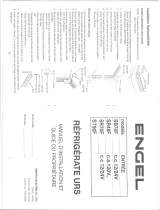
Manuel d’installation 2
Table des matières
Signalisation de la sécurité ....................................................................................................................................................................... 2
Consignes relatives à la sécurité .............................................................................................................................................................. 2
Assemblage de l’enceinte ........................................................................................................................................................................3
Consignes relatives à la ventilation ..........................................................................................................................................................3
Options d’installation ................................................................................................................................................................................4
Pose du (ou des) panneau(x) décoratif(s) de porte...........................................................................................................................4
Inversion du pivotement de la porte (modèles DE / EV0041) ...........................................................................................................5
Inversion du pivotement de la porte (modèles DE / EV0061) ...........................................................................................................8
Raccordement du tuyau de vidange ....................................................................................................................................................... 11
Installation du réfrigérateur ..................................................................................................................................................................... 11
Connexion des composants électriques ................................................................................................................................................. 12
Courant électrique nécessaire.........................................................................................................................................................12
Branchement à l’alimentation 120 / 220 V c.a. ................................................................................................................................12
Branchement à l’alimentation 12 / 24 V c.c. ................................................................................................................................... 12
Consignes relatives à la sécurité
Signalisation de la sécurité
Lire soigneusement ce manuel et en assimiler le contenu avant d’installer le réfrigérateur.
Prendre conscience des risques pour la sécurité signalés par le symbole de mise en garde sur le réfrigérateur et dans ce manuel. Le
symbole de mise en garde est suivi d’un terme précisant la nature du risque en question. Lire soigneusement la description de ces
termes de signalement pour apprendre à les diérencier. C’est une question de sécurité personnelle.
Ce terme de signalement indique un danger qui, s’il n’est pas pris en compte, peut causer une
blessure grave, la mort ou d’importants dégâts matériels.
Ce terme de signalement indique un danger qui, s’il n’est pas pris en compte, peut causer une blessure
légère ou d’importants dégâts matériels.
- Pour les installations nécessitant une prise électrique recevant le courant d’une source d’alimentation externe, le
réfrigérateur doit faire l’objet d’une mise à la terre électrique conforme aux codes locaux ou à la norme NEC NFPA 70.
- Une faute d’installation, de réglage, de modication ou d’entretien de ce réfrigérateur peut causer des préjudices
corporels et (ou) matériels.
- Observer les consignes de la section « Consignes relatives à la ventilation » de ce manuel.
- Ne pas contourner ou modier les composants ou fonctions électriques du réfrigérateur.
- Protéger le câblage contre les dommages matériels, vibrations et excès de chaleur.
- Ne pas vaporiser de liquides près des prises électriques, des raccords ou des pièces du réfrigérateur. Nombre
de liquides sont conducteurs et peuvent poser des risques de décharge électrique, de court-circuit, voire même
d’incendie.
- Cet appareil est prévu pour une utilisation ménagère et dans des applications similaires, par exemple véhicules de
loisir, bateaux et poids lourds.
!
!
!




















